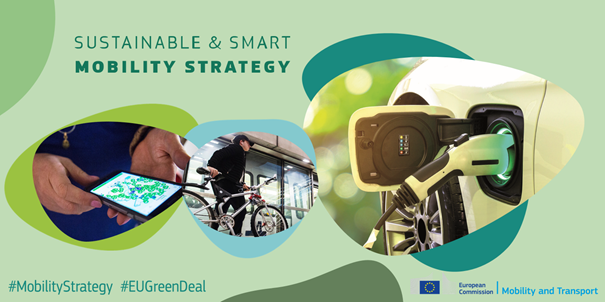The publication of the European Commission’s Sustainable and Smart Mobility Strategy signals the beginning of a process to deliver a legal framework which meets the needs of the rail freight industry. ERFA welcomes the publication of the Sustainable and Smart Mobility Strategy and anticipates an ambitious revision of the key legal texts included within the Strategy.
ERFA believes the Strategy’s focus on modal shift is essential. It will not be possible to bring Europe’s greenhouse gas emissions under control without addressing transport emissions. Although greenhouse gas emissions in the EU-27 decreased by 3.7% in 2019, the transport industry continues to be the only sector of the European economy which is still experiencing year-on-year increases in its greenhouse gas emissions.
Freight transport is no exception. As the most sustainable mode of transport, rail has to play a larger role. Achieving a balanced modal shift through growing rail freight is therefore correctly one of the primary goals in the Sustainable and Smart Mobility Strategy. The Strategy sets out a clear objective of increasing rail freight volumes by 50% by 2030 and doubling rail freight volumes by 2050. This is achievable if the correct framework is in place. The Commission’s Communication sets out a number of strategic legislative revisions which will play an important role.
ERFA appreciates that the strategy includes a revision of the Rail Freight Corridors Regulation and the TEN-T Regulation. It is appropriate and correct that these two Regulations should be addressed together given their mutual importance to one another. Legislation must ensure that the rail freight corridors meet key parameters such as being P400 compatible and facilitating 740m trains along the entirety of the corridors. It is crucial the legal framework also ensures that these parameters are met in operational terms and openly available and accessible to all rail freight operators.
The revision must also introduce clear rights for rail freight when operating on the corridors. For instance, legislation should guarantee that when a freight train is operating according to schedule, its operations should not be disturbed to accommodate other traffic. Rail freight can only perform seamlessly across borders if it has clearly defined rights at international level. This will be an essential precondition to growing rail freight volumes by 50% by 2030.
The European institutions must also address capacity management. The COVID-19 pandemic has shown that when rail freight has a sufficient and legally secured quantity and quality of infrastructure slots, it can provide an attractive and reliable service. This lesson must be carried forward into the legislative process whilst also taking into consideration the good work already being carried out on international timetabling. Different options to address capacity management should be assessed during the impact assessment of the Rail Freight Corridors Regulation.
ERFA President, Dirk Stahl, commented, “We all are aware that rail is the cleanest and most sustainable mode of transport. The Sustainable and Smart Mobility Strategy is a welcome occasion to tackle the shortcomings of the current legal framework and make rail freight thrive not only as a sustainable, but also as an efficient and smart mode of freight transport”.
Conor Feighan, ERFA Secretary General, stated, “The roadmap being put forward by the European Commission is appropriate and targets the key legislation that needs to be revised. We eagerly anticipate the upcoming legislative proposals and remain optimistic that there will be a strong political support from the European Parliament and European Council for ambitious revisions which deliver for rail freight. We are hopeful for open discussions which result in industry experiences being successfully taken onboard”.



